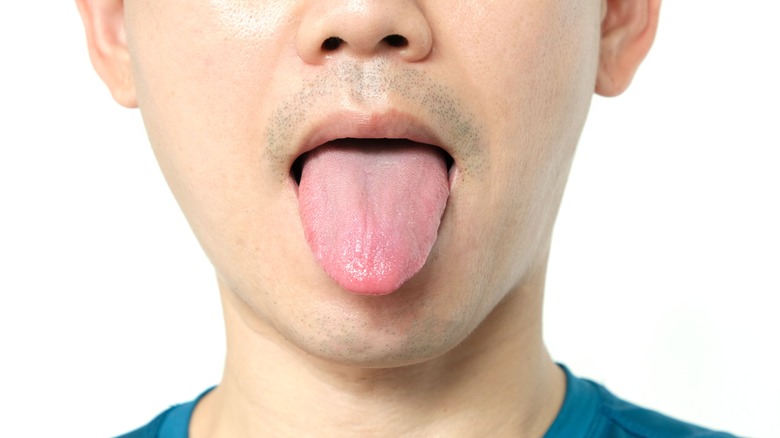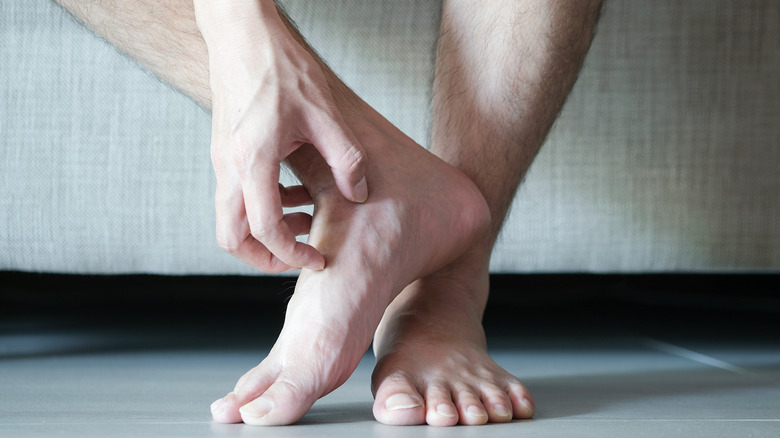Symptoms Of Diabetes Men Shouldn't Ignore
There's no denying diabetes is on the rise. According to the Centers for Disease Control and Prevention (CDC), about thirty-seven million Americans –around 10% of the population — are affected by it. What's worse, 96 million Americans are prediabetic, and of those, 80% aren't aware of this. Given those scary stats, staying on top of symptoms is a smart move.
There are three types of diabetes — type 1, type 2, and gestational, per the CDC. Type 1 diabetes is an autoimmune disorder that typically develops during childhood. In the case of this type of diabetes, the body isn't able to produce enough insulin to manage blood sugar levels. There is no known prevention for type 1 diabetes. Gestational diabetes occurs during pregnancy and usually subsides after childbirth. Type 2 diabetes accounts for the vast majority of diabetes cases and is a result of your body not utilizing insulin appropriately. The good news is that it is preventable with dietary and lifestyle changes.
If left undetected and untreated, diabetes can have adverse effects on your organs and lead to permanent damage and lifelong complications, per WebMD. Recognizing any symptoms is key. An article published in The Journal of Clinical Endocrinology & Metabolism in 2016 found that men are two times more likely than women to develop type 2 diabetes. Because it can manifest differently between the genders, there are some specific sneaky signs of diabetes men should keep an eye out for (via Medical News Today).
Urinary complications may arise from diabetes
A fairly well-known and classic sign of diabetes is frequent trips to the bathroom due to increased urination and an overactive bladder. The higher amounts of sugar in your blood cause your kidneys to work harder to filter the glucose and pass it out of your body through your urine. Your kidneys are producing more urine around the clock to rid the glucose from the body (via Mayo Clinic).
Urinary tract infections (UTIs) are also a potential symptom of diabetes. Though more prevalent amongst women than men, per HealthGrades, there's good reason for men to pay attention if they seem to be dealing with sudden recurring infections. UTIs are common amongst people with diabetes and can be an indication of underlying blood sugar issues, according to a study published in Diabetes, Metabolic Syndrome and Obesity: Targets and Therapy in 2015. Infections are caused by bacteria entering the urinary tract. When diabetes is present, your immune system may not be operating at peak function and is therefore unable to fight off the invaders, allowing the bacteria to grow. Another cause of UTIs is nerve damage, which may lead to a loss of sensation — in turn, this can mean that the bladder doesn't get fully emptied when you pee. The urine that stays behind and sits is more likely to grow bacteria and lead to an infection.
Unquenchable thirst can signal diabetes
Going hand-in-hand with excessive urination is excessive thirst, also known as polydipsia (via Healthline). It's one of the earliest, and most marked, symptoms of diabetes that may lead to a diagnosis. With the kidneys working overtime to excrete the excess blood sugar from your body, the increase in urine output and volume means that water is taken from your tissues. This water loss leaves you insatiably thirsty.
There are many causes of thirst, but if it's extreme, unexplained, and atypical, it could be due to overactive kidneys and dehydration. This increase in thirst also often cooccurs with a dry mouth. If neither is quenched by fluid intake, it could be a sign that your blood glucose levels are elevated, according to Diabetes.co.uk. For this reason, your thirst level is also a handy barometer if you have already been diagnosed with diabetes or prediabetes. Increased thirst that is not satiated by drinking fluids lets you know that your blood sugar levels are too high and need managing.
Oral health issues may be due to diabetes
Oral issues result for a few reasons in connection to diabetes, including dehydration, high levels of sugar in saliva, and lowered immune system function (via the Cleveland Clinic). These problems can affect your mouth and tongue as well as lead to swollen gums. On your next visit to your bathroom, look at yourself in the mirror while making a silly face and sticking out your tongue — this may offer some insight into your blood sugar levels. Diabetes can affect the shape, size, and color of the tongue, according to a study published in Medicine in 2019. For instance, a furry yellow coating on the tongue and/or a blue tinge to the tongue itself were found to be prevalent amongst type 2 diabetic patients.
Diabetes can also lead to yeast overgrowth in the mouth that can cause infection in your tongue, cheek, and gums, per the American Academy of Oral Medicine. Additionally, having red, bleeding, or swollen gums can indicate potential diabetes. High levels of sugar in the blood can lead to high levels of sugar in the mouth, and it may come as no surprise to anyone who's ever had a cavity filled that sugar is no friend to your teeth and gums (via WebMD). And unfortunately, it can become a vicious cycle as diabetes contributes to gum disease, which in turn can negatively impact your body's blood sugar levels and worsen diabetes symptoms.
Fatigue can be a sign of diabetes
Fatigue is fairly common to experience from time to time. Everything from diet to not enough sleep to jet lag can wear us out (per the Mayo Clinic). When fatigue becomes worrisome is when it is chronic and doesn't seem to go away with a good night's rest — these issues may indicate diabetes.
While the exact cause of fatigue due to diabetes can't be pinpointed, there is a perfect storm of factors that may be leave you daydreaming of hitting the pillow all day, according to an article published in Diabetes Therapy in 2018. One may be how the insufficient amount of insulin in the body effects energy regulation, shifting the source of your fuel from carbohydrates to fats. Recurring periods of low blood sugar, or hypoglycemia, may also contribute to a low of energy. A poor diet that leads to diabetes to begin with may also be robbing you of the nutrients needed to sustain energy levels.
Poor sleep quality due to an increased need to use the bathroom during the night, among other factors, may also contribute to daytime fatigue, per a study published in PLoS One in 2016.
Decreased sex drive can indicate diabetes
Perpetually elevated blood glucose levels can interfere with your body's ability to produce testosterone (per Diabetes Strong). Think of the pituitary gland that sits at the base of your brain as the conductor of an orchestra. It has many jobs, explains the Cleveland Clinic, and one is to monitor your blood sugar level at all times and keep it in a safe and healthy range. Another one of its jobs is to release a hormone that controls the function of the testes in men.
When blood sugar levels are consistently too high, the pituitary gland isn't able to produce enough of this luteinizing hormone, which is the hormone responsible for testosterone production (via Diabetes Strong). Low testosterone levels in men has been linked to a decreased libido and lack of interest in sex, as well as lower energy, according to the American Diabetes Association. Men with diabetes are two times as likely to experience lower levels of testosterone than those without it.
There is a strong association between diabetes and sexual dysfunction
Men who have diabetes are more than three times more likely to develop erectile dysfunction than men who do not have diabetes, per a systematic review published in Diabetic Medicine in 2017. The inability to achieve or maintain an erection can be due to blood vessel or nerve injury caused by elevated blood sugar levels (via Mayo Clinic). While common erectile dysfunction medications can help, your physician will need to take care not to prescribe them alongside certain other medications — such as some heart medicines — with which they may have an unsafe interaction (via WebMD). Generally, diabetic men who also have heart problems might not be able to take drugs for erectile dysfunction.
Difficulty maintaining an erection may be an early clue that your blood sugar regulation is off. Getting a diagnosis and managing your diabetes can stop the progression of sexual dysfunction, but any nerve damage is irreversible, notes Medical News Today.
Retrograde ejaculation may be a sign of diabetes
Retrograde ejaculation, also known as dry ejaculation, is a symptom to watch out for. It's when semen is emitted into the bladder instead of exiting the body through the penis, explains the Mayo Clinic. It is not harmful and doesn't affect sexual performance or your orgasm, but it can lead to difficulty getting your partner pregnant. Elevated blood sugar levels can lead to nerve damage which may affect the contractions in the urethra, per a case study published in 2017 in Urology Case Reports.
Retrograde ejaculations can be partial or completely dry, and those with this condition may notice their pee looks cloudy if they urinate shortly after orgasm. A physician can determine if someone has retrograde ejaculation by analyzing their post-orgasm urine to determine if it contains sperm (per the Mayo Clinic). While this symptom typically has a later onset, there is a strong association between retrograde ejaculation and diabetes, and the condition can lead to infertility. For this reason, diabetes is worth ruling out with your healthcare provider if you are experiencing dry ejaculations.
Chronic athlete's foot can be a clue you have diabetes
Athlete's foot, or tinea pedis, is a fungal infection that is usually found on the feet, especially between the toes and on the sole of the foot, though it can spread from those locations (via the Mayo Clinic). Damp locker rooms may be what first comes to mind when considering the cause of an athlete's foot, but it can be a fairly common symptom of diabetes. And while not serious, it is often painful and may lead to complications, especially in people with diabetes, if left untreated (via Podiatry Today).
Our immune system is hard at work fighting off infections at all times. Diabetes lowers our immunity, however, and allows yeast to quickly overgrow on the skin. In turn, these fungal infections can contribute to the formation of ulcers on the feet, according to a study published in the Pakistan Journal of Medical Sciences. And because diabetes also leads to nerve damage such as neuropathy, which affects our limbs and leads to numbness, small cuts or wounds like ulcers can go unnoticed and become infected (via the Mayo Clinic). All that to say, while it's not typically serious on its own, athlete's foot in someone who's diabetic can lead to a host of other, more serious complications.
Poor muscle strength can indicate diabetes
Your next visit to the weight rack at the gym may also offer an unexpected clue to possible blood sugar regulation issues. While there are many factors that contribute to the need to reach for a smaller barbell or lower your rep count from time to time, those with diabetes may lose more muscle mass than usual, resulting in poor muscle strength. A study published in Medicine in 2018 found a correlation between type 2 diabetes and handgrip strength (which, according to a study in The Journal of Strength and Conditioning Research, is indicative of general muscle strength). The study, conducted on Korean adult males, found an inverse relationship between fasting glucose, HbA1c, fasting insulin levels, and performance on the strength test (per Medicine). Meaning, the higher the level of sugar and insulin in the blood, the less strength the men demonstrated.
Per the CDC, insulin is a hormone that is responsible for transporting glucose into your cells, and in turn promotes the growth of cells. Diabetes is the result of insulin not being able to fully do its job. According to the study's researchers, the connection between lower muscle mass and diabetes may be that the diminished activity of insulin stunts the growth of muscle cells (via Kobe University).
Blurred vision can be an early sign of diabetes
Your annual trip to the eye doctor may be helpful in flagging diabetes (via UT Southwestern Medical Center). Blurred vision, eye floaters, and seeing less vivid colors can offer a clue into blood sugar regulation issues in your body that an attuned ophthalmologist can catch. There are four main causes for vision issues at play: diabetic retinopathy and macular edema (both affect the retina), cataracts, and glaucoma.
Diabetic retinopathy is a result of chronically elevated blood sugar levels causing damage to the blood vessels in your retina. Diabetic macular edema occurs when fluid collects in your retina. While both are treatable, they can lead to blindness if not addressed promptly and appropriately. Cataracts occur when the lenses of your eyes become cloudy. It is a common part of growing older, but presents earlier and more often in those with diabetes (via National Institute of Diabetes and Digestive and Kidney Diseases). Glaucoma affects the optic nerves, which connect your eyes to your brain, and may cause blindness.
High levels of blood sugar can cause changes to the skin
Damage to your blood vessels from chronically elevated blood sugar frequently affects your body's largest organ — your epidermis (via the CDC). Various symptoms can serve as evidence that something may be off-balance underneath.
A common skin occurrence that is closely associated with diabetes is acanthosis nigricans, which are dark patches. They typically show up on the neck, armpits, and groin, and appear velvety. Additionally, bacteria love sugar, so it's no surprise that staph infections flourish when blood sugar levels are high. Common areas it pops up in are eyelids, fingernails, and hair follicles. And the same reason diabetes can have you visiting the restroom often and guzzling water — excess urination and water loss as your body attempts to expel excess sugar — can also cause your skin to dry out and itch.
Skin tags — growths that hang from a stalk and often appear on the neck, armpits, eyelids, or groin — may be another indicator of diabetes (via American Academy of Dermatology Association). Per a cross-sectional study published in BMC Research Notes in 2020, skin tags are believed to be the result of high levels of circulating insulin. The study found that 59% of participants with skin tags on either the cervix or armpit also had diabetes. The authors note, though, that more research on the relationship between insulin and skin tags is needed.
Diabetes may affect sperm and fertility
The effect of diabetes on fertility is an often-discussed topic between women and their healthcare providers (via UNC Fertility). What tends to be overlooked is how a man's blood sugar regulation may be a factor at play in any conception hurdles a couple is facing. Diabetes may have an effect on various aspects of sperm quality — for instance, someone with diabetes may have lower sperm motility, or the sperm DNA may be abnormal. These factors can lead to a more difficult time conceiving, according to a study published in the Asian Journal of Andrology in 2015. In addition, changes to sperm and seminal fluid can be passed onto future generations, upping the odds of your offspring developing diabetes.
Not only can the quality of sperm be adversely affected by diabetes, the volume may be diminished as well. A meta-analysis published in Diabetology & Metabolic Syndrome in 2021 found a reduced semen volume associated with diabetes.
Risk factors of diabetes to watch out for
While symptoms of diabetes and their severity will differ from man to man, it's worth being extra diligent and staying on top of your health if you suspect you may be at risk of developing diabetes, per the American Heart Association. Some risk factors for prediabetes and type 2 diabetes are immutable, such as your age and genetics. If close relatives have developed type 2 diabetes, you are at an elevated risk of developing it yourself. Those of African-American, Asian-American, Latino/Hispanic-American, Native American, or Pacific Islander descent also have higher odds of developing type 2 diabetes. Being older — particularly belonging to the 40+ age group — also means you're more likely to have the condition.
The other factors are in your control. While being overweight or obese ups your odds, losing just 5% of your total body weight slashes that risk significantly. Exercise also mitigates your risk. Just a brisk walk most days a week may counteract insulin resistance, which often leads to diabetes. Quitting smoking, monitoring blood pressure and cholesterol, and limiting alcohol also keep diabetes at bay, as does getting enough sleep and managing stress. And most importantly, diet is completely in your control (via CDC).














